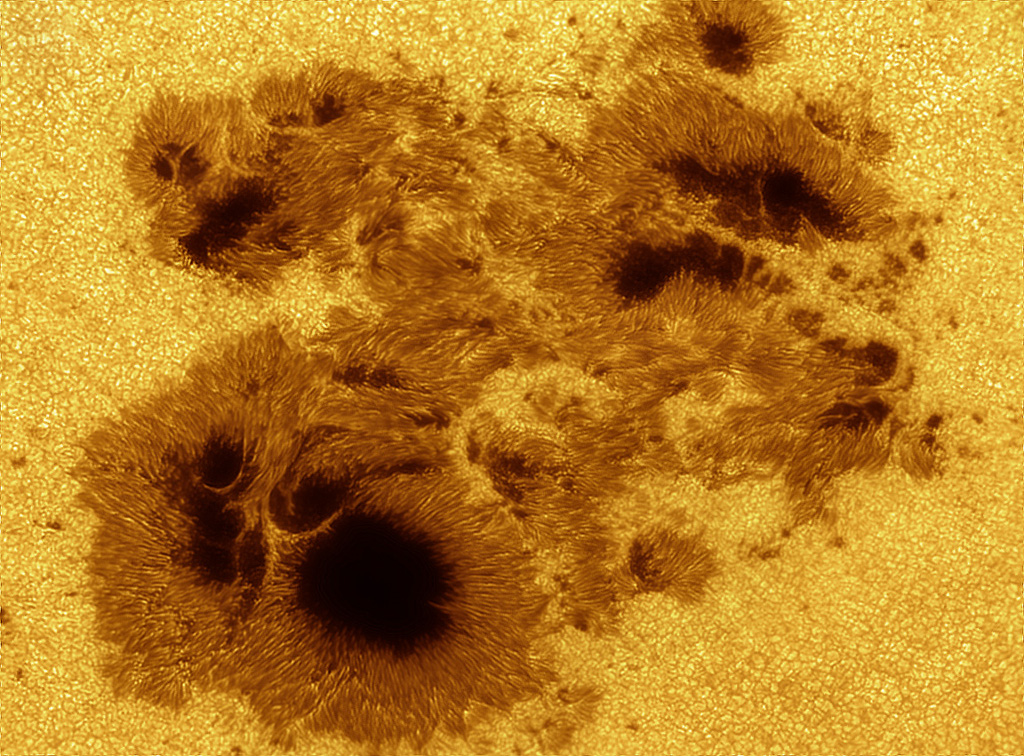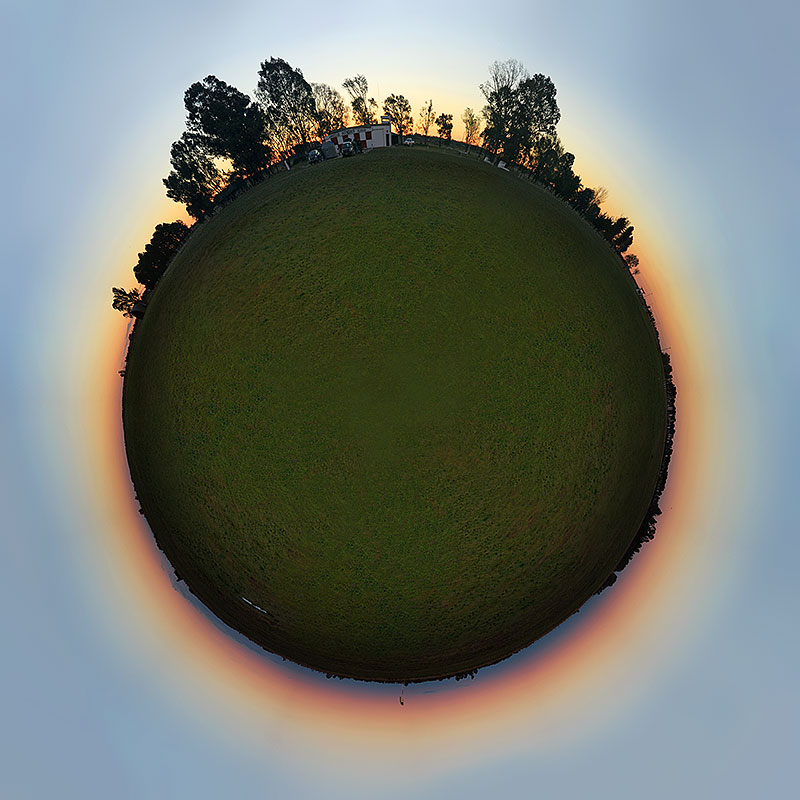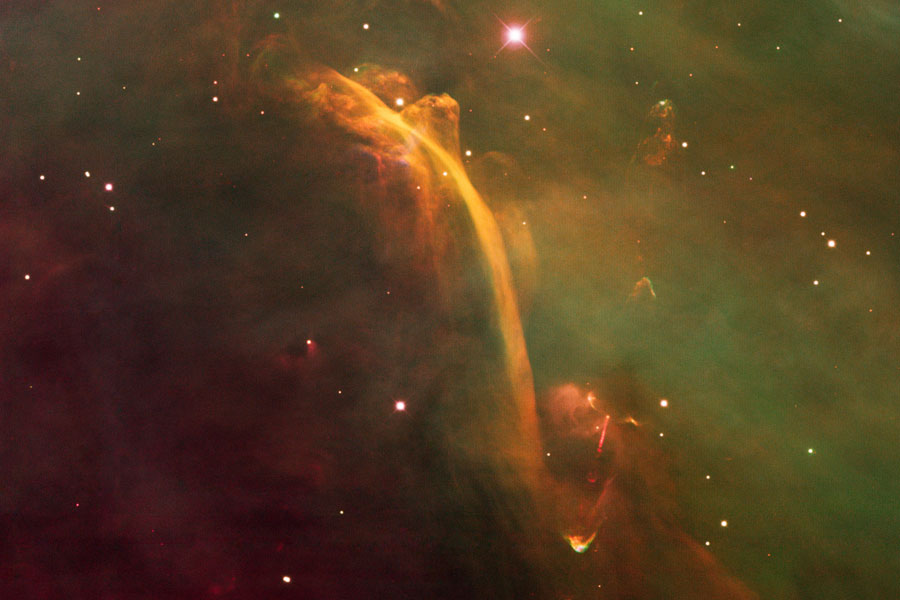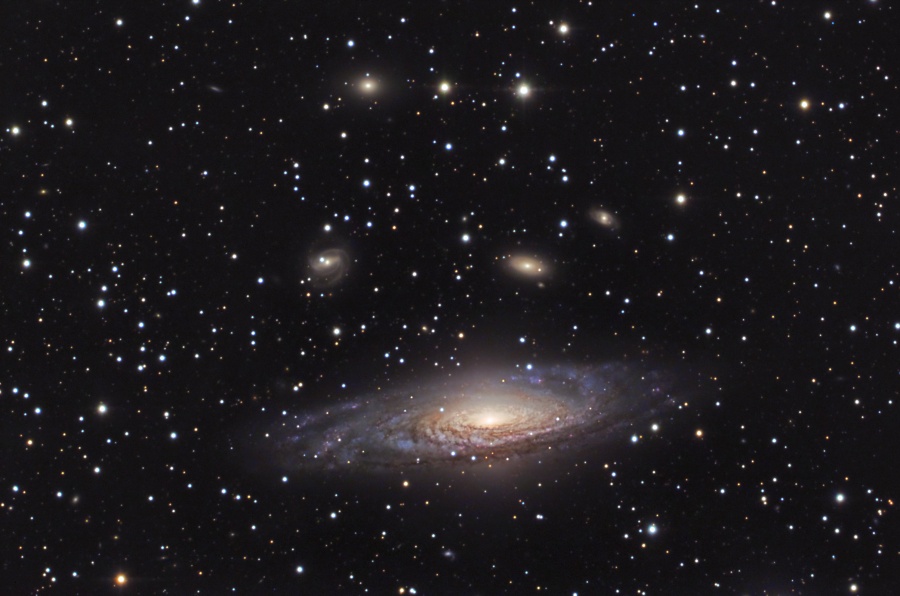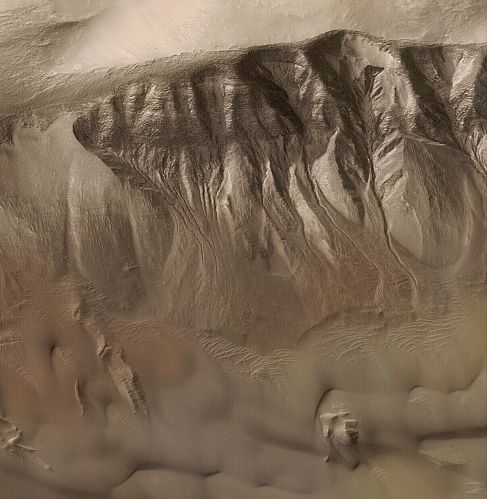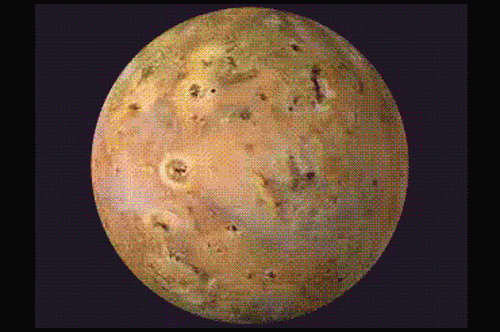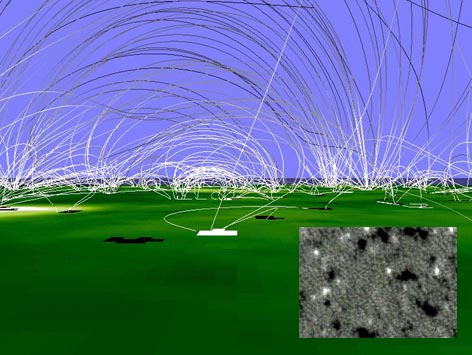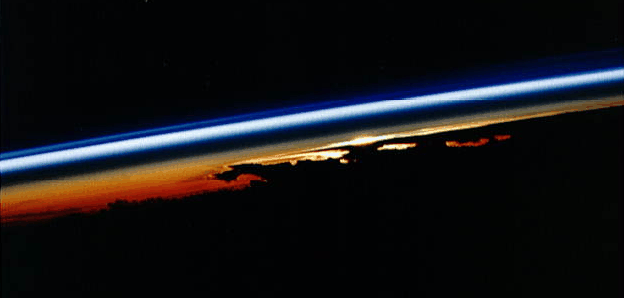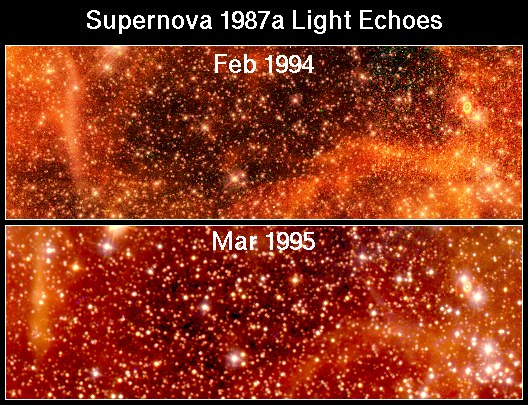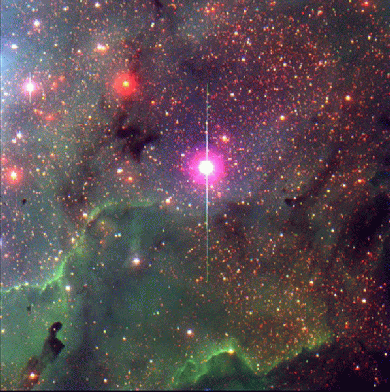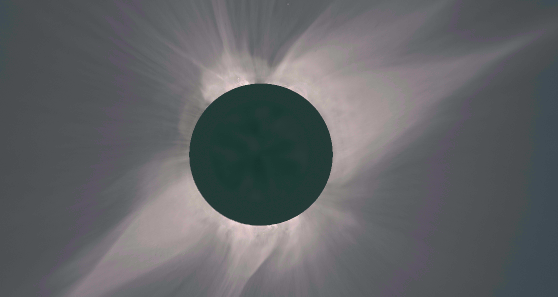| << Previous | Index | Next >> |
2014 As you (safely!) watched the progress of yesterday's partial solar eclipse, you probably also spotted a giant sunspot group. Captured in this sharp telescopic image from October 22nd the complex AR 2192 is beautiful to see, a sprawling solar active region comparable in size to the diameter of Jupiter. Like other smaller sunspot groups, AR 2192 is now crossing the Earth-facing side of the Sun and appears dark in visible light because it is cooler than the surrounding surface. Still, the energy stored in the region's twisted magnetic fields is enormous and has already generated powerful explosions, including two X-class solar flares this week. Coronal mass ejections (CMEs) associated with the flares have not affected planet Earth, so far. The forecast for further activity from AR 2192 is still significant though, as it swings across the center of the solar disk and Earth-directed CMEs become possible.
2013 Warm shades and subtle colors come to the sky in the fading sunlight after shadowrise on this little planet. Of course the little planet is planet Earth, and this nadir-to-zenith, around-the-horizon mosaic maps the view from a small airfield near the town of Intendente Alvear, La Pampa province, Argentina. Just above the western horizon (top) the sky shines with the warm colors of sunset. The slate blue shadow of Earth itself extending through the atmosphere can be seen rising as it hugs the eastern horizon (bottom). Wrapped closely above the narrow projection of Earth's shadow is the gentle glow of reddened, backscattered sunlight called the antitwilight arch or the Belt of Venus.
2012 The large stellar association cataloged as NGC 206 is nestled within the dusty arms of neighboring spiral galaxy Andromeda (M31), 2.5 million light-years distant. Seen near the center of this gorgeous close-up of the southwestern extent of Andromeda's disk, the bright, blue stars of NGC 206 indicate its youth. Its youngest massive stars are less than 10 million years old. Much larger than the clusters of young stars in the disk of our Milky Way galaxy known as open or galactic clusters, NGC 206 spans about 4,000 light-years. That's comparable in size to the giant stellar nurseries NGC 604 in nearby spiral M33 and the Tarantula Nebula, in the Large Magellanic Cloud.
2011
2010 Please wait while one of the largest mobile machines in the world crosses the road. The machine pictured above is a bucket-wheel excavator used in modern surface mining. Machines like this have given humanity the ability to mine minerals and change the face of planet Earth in new and dramatic ways. Some open pit mines, for example, are visible from orbit. The largest excavators are over 200 meters long and 100 meters high, now dwarfing the huge NASA Crawler that transports space shuttles to the launch pads. Bucket-wheel excavators can dig a hole the length of a football field to over 25 meters deep in a single day. They may take a while to cross a road, though, with a top speed under one kilometer per hour.
2009 Big, beautiful spiral galaxy NGC 7331 is often touted as an analog to our own Milky Way. About 50 million light-years distant in the northern constellation Pegasus, NGC 7331 was recognized early on as a spiral nebula and is actually one of the brighter galaxies not included in Charles Messier's famous 18th century catalog. Since the galaxy's disk is inclined to our line-of-sight, long telescopic exposures often result in an image that evokes a strong sense of depth. The effect is further enhanced in this deep image by the galaxies that lie beyond the gorgeous island universe. The background galaxies are about one tenth the apparent size of NGC 7331 and so lie roughly ten times farther away. Their strikingly close alignment on the sky with NGC 7331 occurs just by chance. The visual grouping of galaxies is also known as the Deer Lick Group.
2008 One year ago, Comet 17P/Holmes amazed sky watchers across planet Earth. A stunningly rapid outburst transformed it from a faint comet quietly orbiting the Sun with a period of about 7 years to a naked-eye comet rivaling the brighter stars in the constellation Perseus. Its largely tail-less shape, as in this wide-angle view recorded on November 11, 2007, became well-known to astronomers trying to unravel the mystery of the comet's surprising outburst . Still, Comet Holmes had a dim ion tail that was seen to separate from the bright coma. In this image, the separated tail creates the illusion of a reflection nebula. It appears as a faint bluish haze right of center against a background of stars in the loosely grouped Alpha Persei Moving Cluster.
2007 Scroll right and cruise above the thin, icy rings of Saturn. This high resolution scan is a mosaic of images presented in natural color and recorded in May, over about 2.5 hours as the Cassini spacecraft passed above the unlit side of the rings. The rings themselves are seen to be composed of many individual ringlets. To help track your progress, the rings are labeled below, along with the distance from the center of the gas giant in kilometers. Major ring gaps are labeled above. The alphabetical designation of Saturn's rings is historical and related to their order of discovery; rings A and B are the bright rings separated by the Cassini division. In order of increasing distance from Saturn, the seven main rings run D,C,B,A,F,G,E. (Faint, outer rings G and E are not imaged here.)
2006
2005 Why isn't this sand round? The robotic Spirit rover currently rolling across Mars has found notably angular sand in the Columbia Hills on Mars. Previously, small bits of sand found in the plains of Gusev Crater were significantly more round. The finding indicates that angular hill sand has tumbled less and likely traveled a shorter distance than the corresponding round plain sand. Such tumbling has the general effect of making sand and rocks increasingly round and with fewer sharp edges. Pictured above, as taken last month, are angular sand grains magnified by Spirit's Microscopic Imager. The above frame spans about three centimeters.
2004 From afar, the whole thing looks like an Eagle. A closer look at the Eagle Nebula, however, shows the bright region is actually a window into the center of a larger dark shell of dust. Through this window, a brightly-lit workshop appears where a whole open cluster of stars is being formed. In this cavity tall pillars and round globules of dark dust and cold molecular gas remain where stars are still forming. Already visible are several young bright blue stars whose light and winds are burning away and pushing back the remaining filaments and walls of gas and dust. The Eagle emission nebula, tagged M16, lies about 6500 light years away, spans about 20 light-years, and is visible with binoculars toward the constellation of Serpens. The above picture combines three specific emitted colors and was taken with the 0.9-meter telescope on Kitt Peak, Arizona, USA.
2003
[imghover6=http://apod.nasa.gov/apod/image/0310/ma ... 20803b.jpg]http://apod.nasa.gov/apod/image/0310/ma ... abeled.jpg[/imghover6]Credit & Copyright: Johannes Schedler (Panther Observatory)
2002 The Gullies of Mars would probably not have been sensational enough for the title of a vintage Edgar Rice Burroughs story about the Red Planet. But it would get the attention of planetary scientists today. First identified in high resolution images of Mars recorded by the orbiting Mars Global Surveyor spacecraft, the gullies are interpreted as startling evidence that liquid water flowed across the martian surface in geologically recent times. Similar channels on Earth are formed by flowing water, but on Mars the temperature is normally too cold and the atmosphere too thin to sustain liquid water. Still, it is thought possible that water did burst out from underground layers and remain liquid long enough to erode the gullies, while alternative explanations suggest the erosion was produced by a flowing jumble of solid and gaseous carbon dioxide. Spanning a few kilometers along the wall of an impact crater this high resolution image from Mars Global Surveyor shows typical martian gullies near the top of the crater wall giving way to sand dunes toward the crater floor. Whitish frost is visible near the top and on the dark sand dunes below. The muted colors were synthesized from wide angle image data.
2001 Situated over 2,000,000,000 (two billion) light-years from Earth, galaxies in cluster Abell 2390 (top) and MS2137.3-2353 (bottom) are seen in the right hand panels above, false-color images from the Hubble Space Telescope. Corresponding panels on the left reveal each cluster's x-ray appearance in images from the Chandra X-ray Observatory. While the Hubble images record the cluster's star-filled galaxies, the x-ray images show no galaxies at all ... only multi-million degree hot intracluster gas which glows in high energy x-rays. But there lies a profound mystery. The total mass in the galaxies on the right, plus the mass of the hot gas on the left, falls far short of providing enough gravity to confine the hot gas within the galaxy clusters. In fact, the best accounting to date can only find 13 per cent (!) of the total matter necessary. Gravitational lens arcs visible in the deep Hubble images also indicate these clusters have much more mass than directly identifiable in the Chandra and Hubble data. Astronomers conclude that most of the cluster matter is dark matter, invisible even to the combined far-seeing eyes of these orbiting astrophysical observatories. What is the nature of this cosmic dark matter?
2000 The surface of Io is continually changing. Jupiter's moon is the home to many powerful volcanoes so active they are effectively turning the moon inside out. The above time-lapse sequence is a composite of images taken during two space missions that approached the violent moon: Voyager and Galileo. The sequence shows Io during a complete rotation, which corresponds to a complete revolution around Jupiter since Io always keeps the same face toward the giant planet. The rampant volcanism is thought to be caused by Jupiter's more distant Galilean Moons (Europa, Ganymede, and Callisto) pulling on Io and continually distorting its shape, causing internal frictional heating. Io is composed mostly of rock, with the yellow color originating from sulfur. The causes of many of the other colors remain a topic of research.
1999 The Sun has a magnetic carpet. Its visible surface appears to be carpeted with tens of thousands of magnetic north and south poles joined by looping field lines which extend outward into the Solar Corona. Recently, researchers have revealed maps of large numbers of these small magnetic concentrations produced using data and images from the space-based SOHO observatory. The above computer generated sunscape highlights these effects, with white and black field lines drawn in joining regions of strong magnetism. A close-up of the Solar surface is illustrated in the inset. These small magnetic regions emerge, fragment, drift, and disappear over periods of only 40 hours or so. Their origin is mystifying and their dynamic behavior is difficult to reconcile with present theories of rotationally driven large-scale solar magnetism. Is some unknown process at work? Possibly, but the source of this mystery may well be the solution to another -- the long standing mystery of why the outer Solar Corona is over 100 times hotter than the sun's visible surface! The SOHO data reveal that energy released as these loops break apart and interact seems to be heating the coronal plasma.
1998 Sunrise seen from low Earth orbit by the shuttle astronauts can be very dramatic indeed ( and the authors apologize to Hemingway for using his title!). In this breathtaking view, the Sun is just visible peaking over towering anvil-shaped storm clouds whose silhouetted tops mark the upper boundary of the troposphere, the lowest layer of planet Earth's atmosphere. Sunlight filtering through suspended dust causes this dense layer of air to appear red. In contrast, the blue stripe marks the stratosphere, the tenuous upper atmosphere, which preferentially scatters blue light.
1997 Yesterday's image highlighted reflective rings of light emitted by a supernova explosion. Today's pictures, taken over a year apart, highlight how these echoes are seen to move over time. Visible on the left of each picture is part of a reflective ring, an existing dust cloud momentarily illuminated by the light of Supernova 1987A. Note how the nebulosity reflecting the most light occurs farther to the left in the lower photograph. If you look closely, you can see the actual location of SN 1987A itself on the right of each photograph: it appears in the center of a small yellowish ring. The apparent motion and brightness of these echoes help astronomers understand the abundance and distribution of interstellar nebulae in the LMC galaxy, where the stellar explosion occurred.
1996
1995
| << Previous | Index | Next >> |
